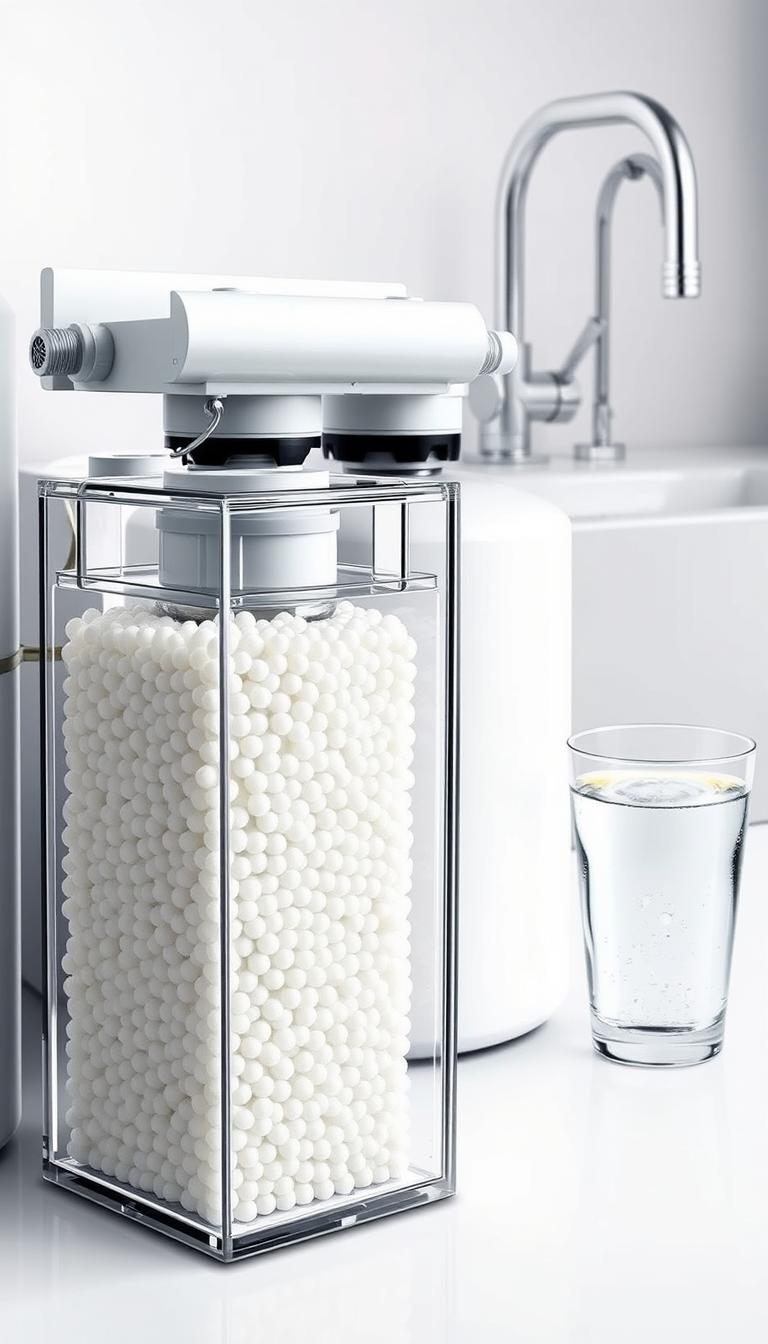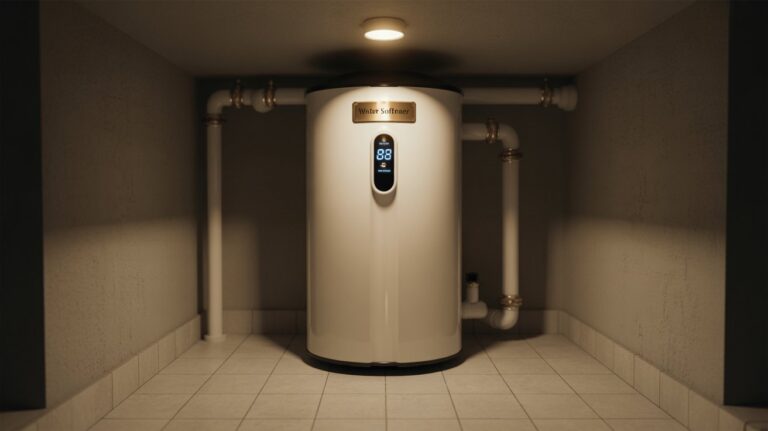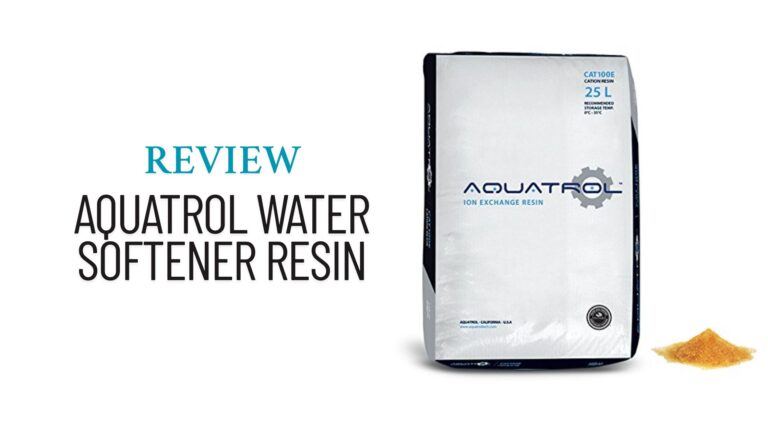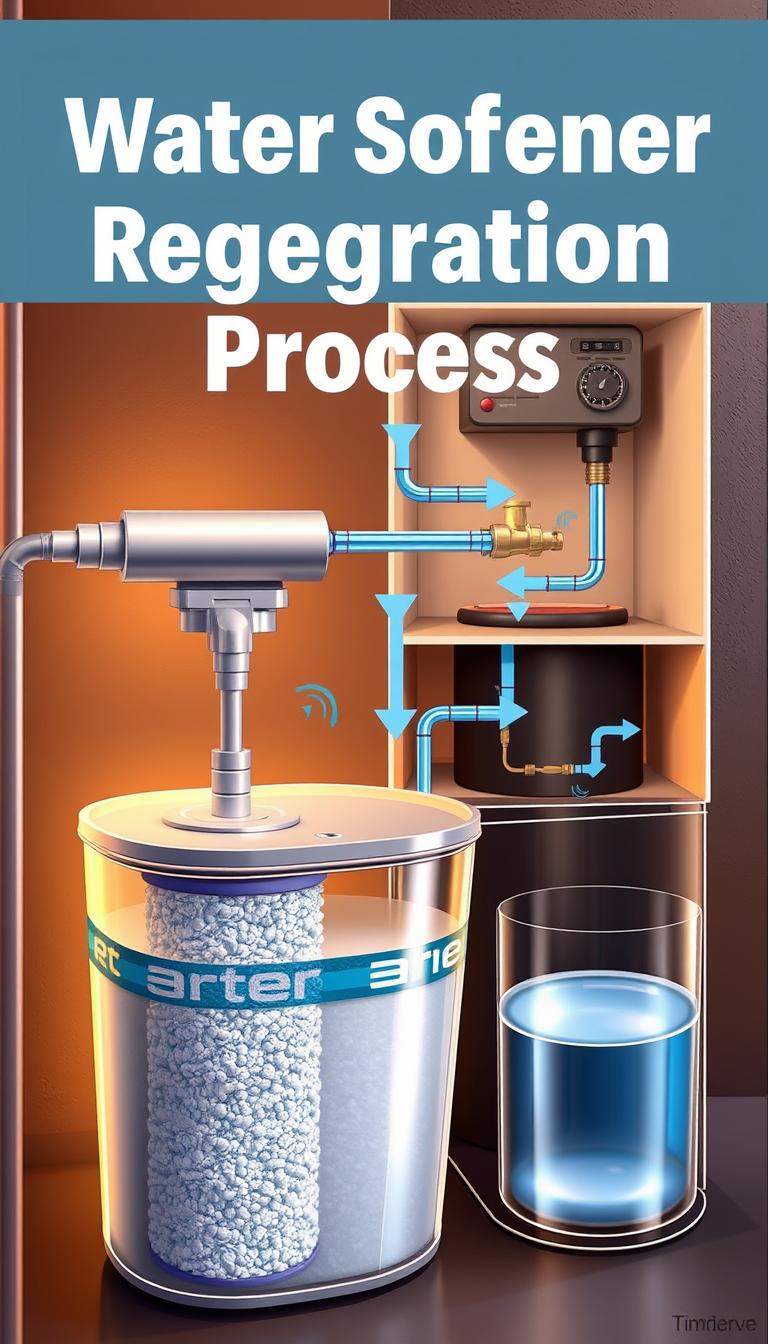Ion Exchange: How Home Water Softeners Work
Are you tired of dealing with the negative effects of hard water on your household appliances and plumbing? Hard water, characterized by high levels of calcium and magnesium, can lead to scale buildup and reduced efficiency.
Ion exchange technology offers a solution by removing these minerals and replacing them with sodium or potassium, resulting in softer water.
Understanding how home water softening systems work is crucial for homeowners looking to mitigate the issues associated with hard water.
Key Takeaways
- Hard water contains high levels of calcium and magnesium.
- Ion exchange technology removes these minerals, replacing them with sodium or potassium.
- Home water softening systems can mitigate the negative effects of hard water.
- Understanding ion exchange is crucial for choosing the right water softener.
- Soft water can improve the efficiency and lifespan of household appliances.
Understanding Hard Water Problems
Understanding the causes and effects of hard water is crucial for maintaining a healthy home. Hard water contains high levels of minerals such as calcium and magnesium, which can cause a range of problems.
What Causes Hard Water?
Hard water is caused by the presence of calcium and magnesium ions in water. As water passes through the ground, it picks up these minerals, which then become part of the water supply. The level of hardness depends on the amount of these minerals present.
Common Hard Water Issues in American Homes
Common issues associated with hard water include scale buildup, reduced appliance efficiency, and soap scum. Scale buildup can clog pipes and reduce the lifespan of appliances, while soap scum can make cleaning more difficult.
Testing Your Water Hardness
Testing your water hardness is essential to determine the level of minerals present. You can use a water testing kit or hire a professional to test your water. The results will help you decide if you need a water softener.
| Water Hardness Level | Effects on Household | Recommended Action |
|---|---|---|
| Soft (0-60 mg/L) | Minimal issues, easy cleaning | No action needed |
| Moderate (61-120 mg/L) | Some scale buildup, soap scum | Consider water softener |
| Hard (121-180 mg/L) | Significant scale buildup, appliance damage | Install water softener |
| Very Hard (181 mg/L+) | Severe scale buildup, plumbing issues | Install water softener, consider additional treatment |
By understanding the causes and effects of hard water, you can take steps to mitigate its impact on your home. Testing your water hardness is the first step towards a solution.
What is Ion Exchange in a Home Water Softener?
Ion exchange is a crucial process in home water softeners that removes calcium and magnesium ions, replacing them with sodium or potassium ions. This process is fundamental to softening water, making it more suitable for household use.
The Basic Science Behind Ion Exchange
The ion exchange process relies on a resin, typically made of sulfonated polystyrene beads, which attracts and holds onto calcium and magnesium ions. These ions are the primary causes of water hardness. The resin is initially saturated with sodium or potassium ions, which are then exchanged for the calcium and magnesium ions as the hard water passes through.
How Ions Are Swapped in the Softening Process
As hard water flows through the resin, the calcium and magnesium ions are drawn to the resin due to their stronger ionic charge compared to sodium or potassium. This results in the calcium and magnesium ions being retained by the resin, while the sodium or potassium ions are released into the water, effectively softening it.
Types of Ions Removed During Softening
The primary ions removed during the softening process are calcium (Ca²⁺) and magnesium (Mg²⁺). These ions are responsible for the scaling and hardness associated with hard water. The efficiency of their removal depends on the type of ion exchange resin used and the regeneration process of the water softener.
| Ion Type | Role in Water Hardness | Effect of Ion Exchange |
|---|---|---|
| Calcium (Ca²⁺) | Causes scaling and hardness | Removed and replaced with sodium or potassium |
| Magnesium (Mg²⁺) | Causes scaling and hardness | Removed and replaced with sodium or potassium |
| Sodium (Na⁺) or Potassium (K⁺) | Used for regeneration | Released into water during softening |
The ion exchange process is a vital component of home water softening systems, providing a reliable method for removing the ions that cause water hardness. Understanding this process can help homeowners appreciate the technology behind their water softeners and make informed decisions about their water treatment needs.
Components of a Water Softening System
The effectiveness of a water softening system depends on its various components, each playing a unique role in the softening process. A typical home water softening system consists of several key parts that work together to remove minerals that cause water hardness.
The Mineral Tank
The mineral tank is the heart of the water softening system, containing the ion exchange resin beads that capture calcium and magnesium ions, replacing them with sodium ions. This process is crucial for softening the water.
The Brine Tank
The brine tank holds the salt used for regenerating the ion exchange resin beads. It’s essential for replenishing the sodium ions that are depleted during the softening process.
Control Valve and Metering System
The control valve regulates the flow of water into and out of the mineral tank, while the metering system monitors water usage to determine when regeneration is necessary. This ensures efficient operation of the water softener.
Ion Exchange Resin Beads
The ion exchange resin beads are critical for the softening process. They attract and hold calcium and magnesium ions, releasing sodium ions into the water. Over time, these beads need to be regenerated or replaced to maintain system efficiency.
| Component | Function |
|---|---|
| Mineral Tank | Contains ion exchange resin beads for softening water |
| Brine Tank | Holds salt for regenerating resin beads |
| Control Valve | Regulates water flow into and out of the mineral tank |
| Metering System | Monitors water usage to determine regeneration need |
Understanding these components of water softener systems is vital for maintaining and troubleshooting your home water softening system. By knowing how each part functions, homeowners can better appreciate the complexity and importance of water softening technology.
The Ion Exchange Process Step-by-Step
At the heart of every water softener lies the ion exchange process, a sophisticated mechanism that replaces calcium and magnesium with sodium. This process is crucial for transforming hard water into soft water, making it more suitable for household use.
Water Flow Through the System
The ion exchange process begins with water flowing into the mineral tank, where it encounters resin beads coated with sodium ions. As the water flows through the resin, the calcium and magnesium ions are attracted to the resin, initiating the exchange process.
How Calcium and Magnesium Are Captured
As hard water passes through the resin, the calcium and magnesium ions are captured by the resin beads, releasing sodium ions into the water. This exchange is the core of the ion exchange process, effectively removing the ions that cause water hardness.
The Role of Sodium in the Exchange
Sodium plays a critical role in the ion exchange process, as it is the ion exchanged for calcium and magnesium. The use of sodium in this process is what allows water softeners to remove hardness ions, resulting in softer water.
Measuring Exchange Efficiency
The efficiency of the ion exchange process can be measured by monitoring the amount of sodium used and the hardness of the output water. Regular testing ensures that the water softener is functioning correctly and that the water is adequately softened.
Understanding the ion exchange process and its step-by-step mechanism is essential for appreciating the technology behind water softeners. By effectively removing calcium and magnesium ions, water softeners improve the quality of water in homes, enhancing appliance lifespan, skin health, and overall household efficiency.
Water Softener Regeneration Cycle
Understanding the regeneration cycle of a water softener is crucial for maintaining its efficiency and effectiveness. The regeneration process is essential for restoring the resin’s capacity to remove hardness ions from the water, ensuring your water softener continues to function optimally.
Why Regeneration is Necessary
Over time, the resin beads in the water softener become saturated with calcium and magnesium ions, reducing their ability to soften water. Regeneration is necessary to restore the resin’s capacity by removing these hardness ions and replenishing the sodium ions.
The Backwash Phase
The regeneration cycle begins with the backwash phase, where water flows backward through the resin tank, loosening and removing any debris or sediment that may have accumulated. This step is crucial for ensuring the resin beads can function properly during the subsequent phases.
The Recharge Phase
During the recharge phase, a brine solution is flushed through the resin tank, where sodium ions from the salt displace the calcium and magnesium ions that have been captured by the resin. This process recharges the resin, enabling it to continue removing hardness ions from the water.
Rinse and Return to Service
After recharging, the system undergoes a rinse cycle to remove any excess brine solution. Once the rinse is complete, the water softener returns to its normal operating mode, ready to continue softening water.
Optimizing Regeneration Frequency
The frequency of regeneration depends on several factors, including water usage, hardness levels, and the type of water softener. Optimizing regeneration frequency is crucial for balancing water softening efficiency with salt and water consumption. Modern water softeners often come with adjustable settings that allow homeowners to customize regeneration frequency based on their specific needs.
By understanding and optimizing the regeneration cycle, homeowners can ensure their water softener operates efficiently, providing consistently softened water while minimizing waste and reducing maintenance needs.
Benefits of Ion Exchange Water Softening
The advantages of using an ion exchange water softener extend far beyond just softer water. By removing calcium and magnesium ions, these systems provide a multitude of benefits that can significantly improve the quality of life and household maintenance.
Extended Appliance Lifespan
One of the most significant benefits of ion exchange water softening is the extended lifespan of household appliances. By reducing the mineral buildup caused by hard water, appliances such as dishwashers, washing machines, and coffee makers can operate more efficiently and last longer. As noted by a leading manufacturer, “Soft water can increase the lifespan of appliances by up to 30%.”
Reduced Soap and Detergent Usage
Soft water requires less soap and detergent to achieve the same level of cleanliness, leading to cost savings over time. This is because soft water allows soap to lather more easily, reducing the amount needed for cleaning. According to a study, households that use soft water can save up to $200 annually on soap and detergent.
Improved Water Heater Efficiency
Ion exchange water softening can also improve the efficiency of water heaters. With scale buildup reduced, water heaters can operate more efficiently, leading to energy savings. It’s estimated that scale buildup can increase energy consumption by up to 30%, making soft water a cost-effective solution.
Better Skin and Hair Health
Soft water is gentler on skin and hair, leading to softer skin and shinier hair. The reduced mineral content means less irritation and dryness, making it particularly beneficial for individuals with sensitive skin.
Reduced Plumbing Maintenance
By minimizing scale buildup, ion exchange water softening reduces the need for frequent plumbing maintenance. This can lead to significant cost savings over time, as pipe replacements and descaling become less necessary.
In conclusion, the benefits of ion exchange water softening are multifaceted, offering advantages that range from appliance longevity and cost savings to improved personal hygiene. As such, investing in an ion exchange water softener can be a wise decision for homeowners looking to enhance their quality of life.
Installation and Maintenance of Water Softeners
Proper installation is the foundation of a water softener’s effectiveness. Ensuring that your water softener is installed correctly is crucial for its performance and longevity. When it comes to installation, homeowners often debate between professional and DIY installation.
Professional vs. DIY Installation
While DIY installation can be cost-effective, professional installation ensures that the job is done correctly and efficiently. Professionals can also provide valuable insights into the optimal placement of the water softener in your home. For those interested in learning more about water softeners, you can check out our beginner’s guide to home water softeners.
Optimal Placement in Your Home
The location of your water softener is critical for its operation. It should be placed near the water supply lines and have adequate drainage. Avoid areas prone to flooding or extreme temperatures to prevent damage to the system.
Regular Maintenance Requirements
Regular maintenance is vital to extend the life of your water softener. This includes checking salt levels, cleaning the brine tank, and inspecting the system for any signs of wear or damage. Regular checks can prevent costly repairs down the line.
Troubleshooting Common Issues
Common issues with water softeners include salt bridges, resin bead fouling, and valve problems. Understanding how to troubleshoot these issues can save time and money.
“Regular maintenance is key to preventing many common water softener issues.”
When to Replace Resin Beads
Resin beads are a crucial component of your water softener. Over time, they can become fouled or worn out, reducing the system’s efficiency. Replacing resin beads when necessary is essential to maintaining your water softener’s performance.
Environmental Considerations and Alternatives
The environmental footprint of ion exchange water softeners has become a significant consideration for homeowners seeking to reduce their ecological impact. While these systems provide numerous benefits, their operation involves certain environmental concerns.
Salt Usage and Environmental Impact
One of the primary environmental concerns associated with traditional ion exchange water softeners is their use of salt. The salt used in the regeneration process can lead to increased salt levels in wastewater, potentially harming aquatic ecosystems.
Water Usage During Regeneration
Another environmental consideration is the water used during the regeneration cycle. This process can consume significant amounts of water, contributing to overall water usage in the household.
Salt-Free Water Conditioning Options
In response to these concerns, salt-free water conditioning options have gained popularity. These systems use alternative technologies, such as template-induced crystallization or catalytic conversion, to condition water without removing minerals or adding salt.
Potassium Chloride as an Alternative
For those who still prefer the ion exchange process, potassium chloride can be used as an alternative to sodium chloride (salt). Potassium chloride is considered more environmentally friendly, as it is less harmful to aquatic life.
Magnetic and Electronic Descalers
Magnetic and electronic descalers represent another category of alternatives. These devices claim to reduce scaling by altering the physical properties of minerals in the water, though their effectiveness can vary.
| Technology | Environmental Impact | Effectiveness |
|---|---|---|
| Ion Exchange with Salt | High salt usage, potential for water waste | High |
| Salt-Free Conditioning | Low environmental impact | Variable |
| Potassium Chloride | Lower than salt, still some environmental impact | High |
| Magnetic/Electronic Descalers | Low | Variable |
When considering a water softening solution, it’s essential to weigh the environmental considerations against the effectiveness and maintenance requirements of each system. By choosing the right technology, homeowners can mitigate the environmental impact while still benefiting from softer water.
Choosing the Right Water Softener for Your Home
The process of picking the perfect water softener involves considering several key factors to ensure it meets your household’s specific needs.
Sizing Based on Water Usage and Hardness
To size a water softener correctly, you need to consider both your daily water usage and the hardness of your water. A water softener that is too small may not effectively soften your water, while one that is too large can be wasteful and more expensive. For instance, a family of four with moderately hard water (around 10 grains per gallon) would typically require a water softener with a capacity of at least 30,000 grains.
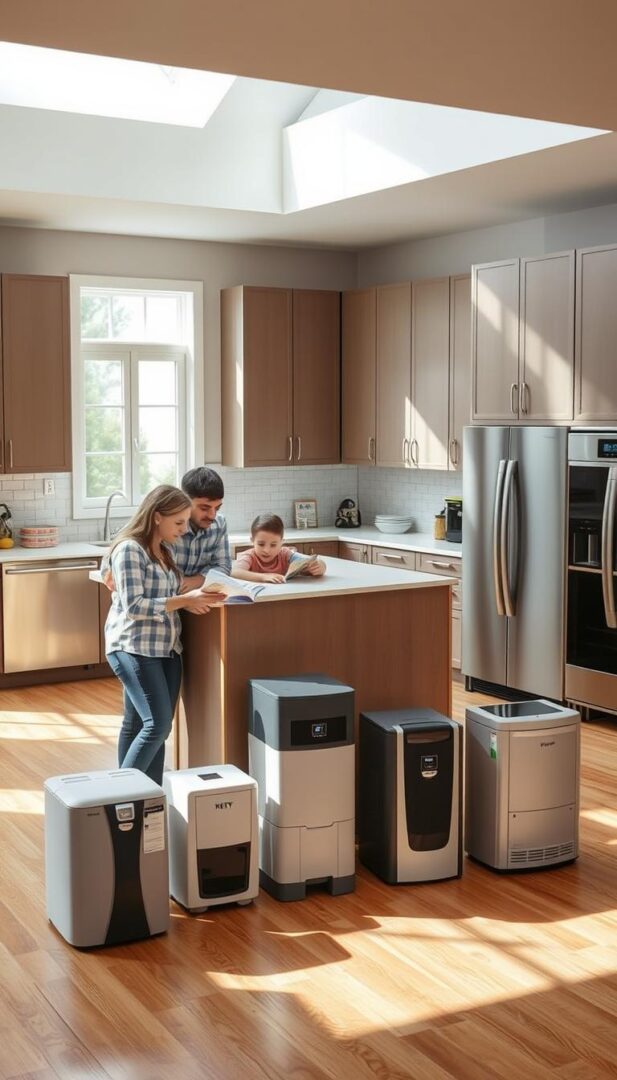
Timer vs. Demand-Initiated Regeneration
Water softeners can regenerate based on a timer or on demand. Timer-based regeneration occurs at set intervals, which can lead to unnecessary regeneration if water usage is low. On the other hand, demand-initiated regeneration regenerates the softener based on actual water usage, making it more efficient and cost-effective.
Salt-Based vs. Salt-Free Systems
The debate between salt-based and salt-free water softeners is ongoing. Salt-based systems are effective but require regular salt replenishment and can have environmental impacts. Salt-free systems, or conditioners, don’t remove minerals but alter them so they don’t stick to surfaces, offering a low-maintenance alternative.
Cost Considerations and ROI
When choosing a water softener, it’s crucial to consider not just the upfront cost but also the long-term operating costs. For example, salt-based systems require ongoing salt purchases, while salt-free systems may have higher initial costs but lower maintenance expenses. You can learn more about the costs associated with different water softener systems on this detailed guide.
| System Type | Initial Cost | Operating Cost | Maintenance |
|---|---|---|---|
| Salt-Based | $500-$1,500 | $50-$100/year (salt) | Regular salt replenishment |
| Salt-Free | $1,000-$3,000 | $0 (no salt needed) | Low maintenance |
Top Brands and Models to Consider
Some top brands in the water softener market include WaterBoss, Frigidaire, and GE. When selecting a model, consider factors like certification (e.g., NSF International), customer reviews, and warranty offered.
Conclusion: The Value of Water Softening Technology
Water softening technology, utilizing ion exchange technology, provides significant benefits for households, including improved appliance efficiency, reduced maintenance, and better water quality. By understanding how ion exchange works, homeowners can appreciate the value of water softeners in addressing hard water problems.
The benefits of water softening are multifaceted, ranging from extended appliance lifespan and reduced soap usage to improved skin and hair health. As discussed, the ion exchange process is crucial in capturing calcium and magnesium ions, replacing them with sodium ions, and thus softening the water.
Investing in a water softener can lead to substantial cost savings over time. With the right system in place, households can enjoy better water quality, reduced plumbing maintenance, and improved overall efficiency. When choosing a water softener, consider factors such as sizing, regeneration type, and salt usage to maximize the benefits of water softening.
By adopting water softening technology, homeowners can enhance their quality of life while protecting their homes from the adverse effects of hard water. The value of water softeners lies in their ability to provide a reliable solution to hard water issues, making them a worthwhile investment for many households.

